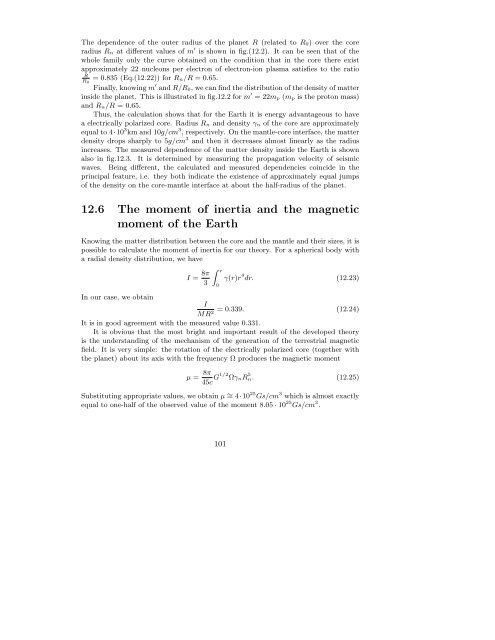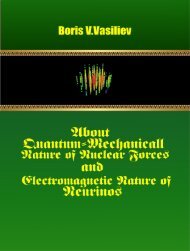VbvAstE-001
Book Boris V. Vasiliev Astrophysics
Book Boris V. Vasiliev
Astrophysics
You also want an ePaper? Increase the reach of your titles
YUMPU automatically turns print PDFs into web optimized ePapers that Google loves.
The dependence of the outer radius of the planet R (related to R 0) over the core<br />
radius R n at different values of m ′ is shown in fig.(12.2). It can be seen that of the<br />
whole family only the curve obtained on the condition that in the core there exist<br />
approximately 22 nucleons per electron of electron-ion plasma satisfies to the ratio<br />
R<br />
R 0<br />
= 0.835 (Eq.(12.22)) for R n/R = 0.65.<br />
Finally, knowing m ′ and R/R 0, we can find the distribution of the density of matter<br />
inside the planet. This is illustrated in fig.12.2 for m ′ = 22m p (m p is the proton mass)<br />
and R n/R = 0.65.<br />
Thus, the calculation shows that for the Earth it is energy advantageous to have<br />
a electrically polarized core. Radius R n and density γ n of the core are approximately<br />
equal to 4·10 3 km and 10g/cm 3 , respectively. On the mantle-core interface, the matter<br />
density drops sharply to 5g/cm 3 and then it decreases almost linearly as the radius<br />
increases. The measured dependence of the matter density inside the Earth is shown<br />
also in fig.12.3. It is determined by measuring the propagation velocity of seismic<br />
waves. Being different, the calculated and measured dependencies coincide in the<br />
principal feature, i.e. they both indicate the existence of approximately equal jumps<br />
of the density on the core-mantle interface at about the half-radius of the planet.<br />
12.6 The moment of inertia and the magnetic<br />
moment of the Earth<br />
Knowing the matter distribution between the core and the mantle and their sizes, it is<br />
possible to calculate the moment of inertia for our theory. For a spherical body with<br />
a radial density distribution, we have<br />
I = 8π 3<br />
∫ r<br />
0<br />
γ(r)r 4 dr. (12.23)<br />
In our case, we obtain<br />
I<br />
= 0.339. (12.24)<br />
MR2 It is in good agreement with the measured value 0.331.<br />
It is obvious that the most bright and important result of the developed theory<br />
is the understanding of the mechanism of the generation of the terrestrial magnetic<br />
field. It is very simple: the rotation of the electrically polarized core (together with<br />
the planet) about its axis with the frequency Ω produces the magnetic moment<br />
µ = 8π<br />
45c G1/2 Ωγ nR 5 n. (12.25)<br />
Substituting appropriate values, we obtain µ ∼ = 4·10 25 Gs/cm 3 which is almost exactly<br />
equal to one-half of the observed value of the moment 8.05 · 10 25 Gs/cm 3 .<br />
101













